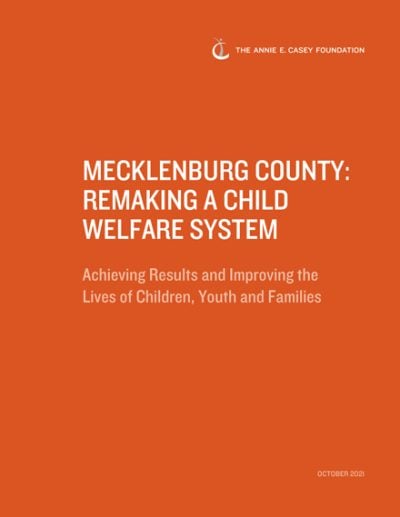Summary
In 2013, child welfare leaders in Mecklenburg County, North Carolina, needed new approaches to keeping families together safely and improving the well-being of children and young people. For situations in which foster care was the only option, they wanted placements to be temporary, with fewer disruptions and less trauma for children and families.
Four years later, with better data systems for analyzing trends, new ways of working with families and communities and a partnership with a national experts, the county’s Youth and Family Services (YFS) is seeing significant, positive results. These include reduced entries into foster care, fewer young people in the system living in group settings, less staff turnover with improved morale, more support for kinship care and increased efforts to end racial disparities.
The reform effort in Mecklenburg Count had three priorities:
- Eliminating racial inequities that were leading to disproportionately high numbers of referrals of Black children and families, as well as longer stays and multiple placements for kids of color
- Decreasing the use of emergency shelter placements and residential care for older youth
- Improving the capacity for data collection and analysis
How YFS Strengthened Its System
- Data reporting was improved. YFS used the data to analyze the experiences of children in foster care in real time and determine how to help them reach standards of well-being built around prevention, safety and support
- Hotline and intake call center operations were overhauled. In 2017, YFS established a dedicated child abuse and neglect hotline that was promoted heavily, as well as an alternate phone number for general inquiries about child protective services, existing cases and needed community resources. This change allowed callers to more efficiently reach the correct staff to address their needs.
- Backlogged investigations of abuse and neglect were brought up to date. YFS, working with the Casey Foundation, designed and implemented a short-term process to make decisions on backlogged cases and close out those that were unnecessarily delayed. A review tool was developed to indicate risk factors and capture the content of the most recent face-to-face visit.
- The YFS practice model became the system’s guiding light. The model outlined how cases should be handled, where children should live, the importance of working in teams, a respect for cultural differences and a commitment to partnerships and working with communities.
- Racial equity and inclusion efforts were part of all strategies. Staff needed regular trainings. YFS leaders needed to identify ways to surface tough conversations about race and collaborate on solutions with partners in school systems, police departments and hospitals, as well as other county agencies
- Kinship care was prioritized. YFS staff were enlisted to be kinship champions; developed a road map of policies, timelines and expectations for staff; and created kinship brochures and a kinship care resource guide to help caregivers understand their role and the licensing process.
- Families for older youth became an important focus for improved outcomes. As the practice model and new tools were being instituted, the overall number of children entering foster care declined significantly, cut almost in half. But the number of older youths, especially Black youth, increased. The data showed that older youth were primarily being placed outside of families, with 80% initially being placed in group settings. In 2019, the agency formed a work group to examine this issue and emphasize permanency planning for older youth.
- Workforce stability had to be addressed. With high vacancy and turnover rates, YFS set a goal to improve recruitment and retention of their staff. Several strategies were implemented in a short period of time, such as ensuring regular, ongoing job postings; implementing a second shift; monitoring overtime; using an HR dashboard; and instituting telework policies.






